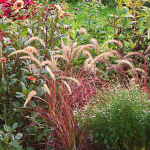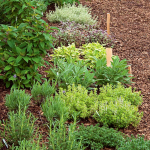Product Details
Savory herbs bring out the best in full-flavored dishes. In this collection we offer 1 plant of each variety listed below, 5 plants total. Container not included.
- Culinary Sage (Salvia officinalis)—Provides excellent peppery flavoring for soups, stuffings, omelets, and cheese recipes.
- Fine Chives—A fancy European strain, Fine Chives grow into the same 1′ tall clumps as regular Chives (Allium schoenoprasum), but their leaves are more refined and tender, tend to regrow faster after cutting, and develop woody stems more slowly. Add the leaves to salads or snip them into small pieces at the last minute over a bowl of hot soup, scrambled eggs, or mashed potatoes.
- Lavender 'Goodwin Creek Grey'—Spikes of deep blue flowers above a lush mound of silver foliage. The dried flowers add distinctive flavors to desserts and combine well with lemon.
- Rosemary (Rosmainus officinalis 'Arp')—Gray-green, lemony scented leaves add great flavoring to roasted meats and vegetables.
- Lemon Thyme (Thymus x citriodorus 'Golden Lemon)—A natural partner with any chicken dish, a perfect herb for seasoning rice and grain dishes, and adds a lemony lift to vegetables and casseroles.
Shipping
HOW PLANTS ARE SHIPPED
The size of the plants we ship has been selected to reduce the shock of transplanting. For some, this means a large, bareroot crown. Others cannot travel bareroot or transplant best if grown in containers. We ship these perennials and annuals in 1 pint pots, except as noted. We must point out that many perennials will not bloom the first year after planting, but will the following year, amply rewarding your patience. We ship bulbs as dormant, bare bulbs, sometimes with some wood shavings or moss. Shrubs, Roses, vines, and other woody plants may be shipped bareroot or in pots. The size of the pot is noted in the quick facts for each item.
WHEN WE SHIP
We ship our bulbs and plants at the right time for planting in your area, except as noted, with orders dispatched on a first-come, first-served basis by climate zone. We also ship a wide range of containers and planters, tools, supplies, fertilizers, garden wear, garden decor items, as well as indoor decorations like wreaths and dried bouquets when available. Estimated dates for shipping are indicated in the green Shipping Details box for each item. Please supply a street address for delivery. Kindly contact us with two weeks notice, if you'll be away at the expected time of delivery.
OUR GUARANTEE
We guarantee to ship plants that are in prime condition for growing. If your order is damaged or fails to meet your expectations, we will cheerfully replace or refund it. Please contact our Customer Service Department at 1-800-503-9624 or email us at [email protected]. Please include your order number or customer number when contacting us.
Reviews
There are no reviews yet. Be first to Write a Review.
Growing guide
Choosing a pot and growing mix. Most of the plants we offer can be grown in containers—any container with a drainage hole in the bottom will suit. The growing medium in containers must drain much more quickly than garden soil. We use a potting mix specifically designed for use in containers. Similar mixes are now available at most garden centers and hardware stores.
Planting. Begin by moistening the potting mix thoroughly. Add moist potting mix to the container until the pot is about 3/4 full. Next, set the plants on the mix, spacing them much more closely than you would when planting them in the ground. Put the tallest plants in the center, surround them with shorter, mounding plants, and put trailing plants along the edge. When you are pleased with your arrangement, add potting mix to bring the level to within an inch of the container’s rim and firm lightly. Finally, water thoroughly.
Container care: water and fertilizer. Plants in containers dry out more quickly than plants in the ground; in the heat of summer, you may have to water them daily. To decrease the need to water, we suggest incorporating a super absorbent gel into the potting mix. With frequent watering, nutrients wash out the bottom of the pot. We recommend that you mix a timed-release fertilizer into the potting mix before you add the mix to the container. In addition, to keep annuals growing and flowering, we suggest you water with a balanced (20-20-20), water-soluble fertilizer, mixed as directed, every other week in summer. Finally, plants in containers may need grooming. Remove spent flowers regularly and prune the stems of vigorous growers to keep them in check.
Preparing for winter. In climates where winter temperatures drop well below freezing, containers should be dismantled in fall. Bring tender plants indoors or toss them on the compost heap; plant hardy perennials such as French Tarragon or Thyme in the ground. Most containers should be emptied and stored under cover where they will not freeze; only plastic and fiberglass pots can be left outside over winter. In mild-winter climates—Zone 8 (10°F) and warmer—hardy plants can generally be left outdoors in containers with little risk to the plants or pots.
GROWING STANDARDS Our standards may be grown in containers or in the ground.
Staking a standard. To keep your standard standing, put it out of reach of strong winds and support it with a stake that has a diameter at least as large as the stem’s and long enough that when plunged into the pot or the ground it just reaches inside the head. Fasten the standard to the stake at several points with twine or plastic ties looped in a figure eight around stem and stake. Check the ties periodically. Loosen them if they constrict the outward growth of the stem.
Pruning, fertilizing, and repotting. Maintain the shape of the head with selective pinching of the new shoots. Pinch each shoot between thumb and forefinger or cut with pruning shears; do not shear the plant as though it were a hedge. Fertilize standards grown in pots as you would other pot-grown plants (see “Container care” above). If you find that a standard in a container dries out quickly after watering, the plant probably needs a larger pot. Lift it from its current pot, make four deep vertical cuts in the root ball, and place it in a new pot that is 2in wider and taller than the old one, filling in around the root ball with fresh potting mix. Water thoroughly after repotting.
Overwintering a standard. Most standards require special care to overwinter. In cold-winter climates, bring standards of Rosemary, Abutilon, Anisodontea, Heliotropium, and Lantana indoors before frost and place them in an east- or west-facing window in a cool room. Water just enough to keep plants from drying out completely. Set back outdoors in spring when nighttime temperatures remain consistently above 55°F.




